blog
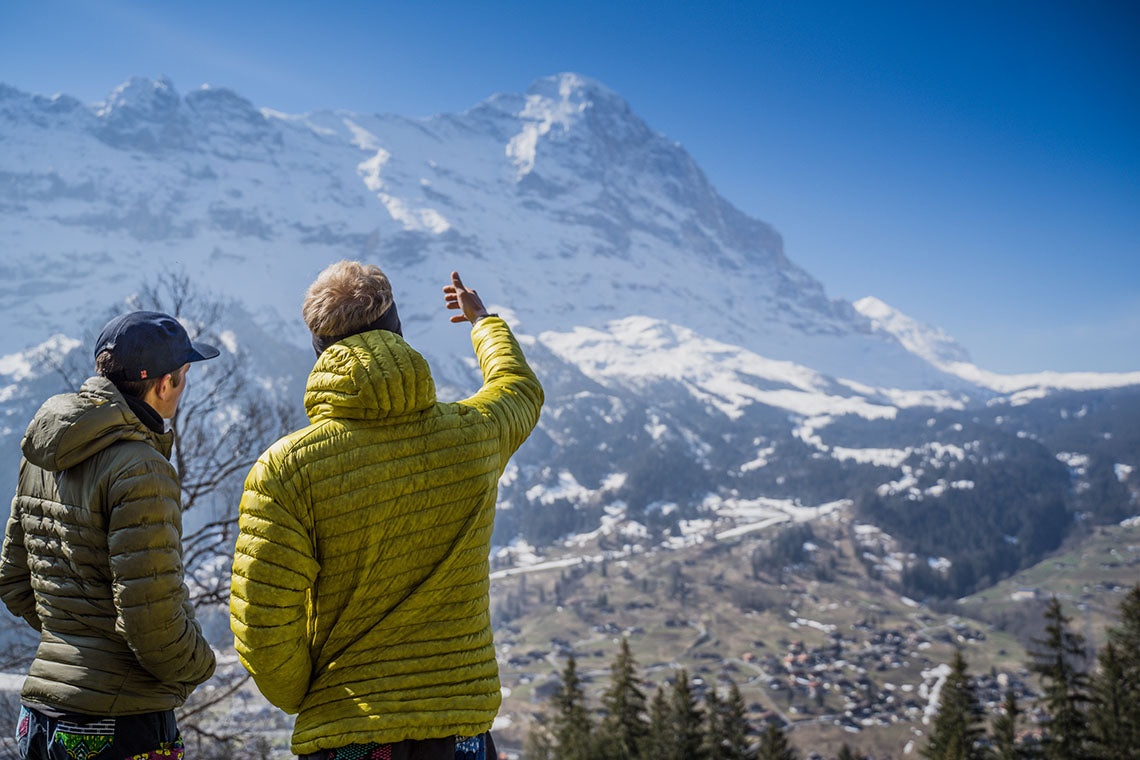
From Bikes to Peaks: The Historic Quest of Bike2Eiger
Join Suunto ambassador Philipp Reiter and his friend Martin Schidlowski as they retrace a historic journey to the Eiger North Face in their film, Bike2Eiger.
Suunto ambassador Philipp Reiter invited his childhood friend and climber Martin Schidlowski on an adventure that combined history with the modern-day challenges of mountaineering. Riding 600 km from their home in Berchtesgadener Land, Germany, to Grindelwald, the base of the Eiger in Switzerland, and attempting to climb its notorious north face was merely the backdrop for something more meaningful and thought-provoking.
We caught up with Philipp to discuss his film, Bike2Eiger. The film has been touring mountain film festivals for the past winter and is now released online. Read on – and watch the film below!
Philipp Reiter and Martin Schidlowski are friends since childhood.
You were following in the footsteps of some true Alpinist legends. Who were they and what was their story?
Anderl Hinterstoisser and Toni Kurz were two alpinists from the Berchtesgadener Land, where Martin and I also grew up. In the 1930s, they wanted to solve the last unclimbed problem of the Alps - the Eiger North Face. As they had no money to travel by train, they went from Bad Reichenhall to Grindelwald by bike. (Read more about them here.)
What is your connection with your adventure buddy Martin?
Martin Schidlowski is my kindergarten buddy. We have done many alpine adventures together, running, climbing, and mountaineering. Since the beginning, we have had the same mindset and passion for the mountains. He is a super good climber and alpinist, and I am more of the endurance athlete in our team.
Not the conditions the duo was hoping for.
The adventure started with three long days in the saddle. How did that go?
Haha, not very well! 1.5 hours after we started, we were stuck and had to push the bikes through 30–40 cm of fresh snow. Generally, it was super cold, and we underestimated the weight of the bags. We carried in all our gear – alpinism by fair means. The first night, the police also kicked us out of our little wood cabin as in Austria sleeping somewhere out counts as illegal camping.
Did you start to question why you didn’t simply drive to the mountain?
We wanted to experience the same as the two pioneers in the 1930s, which is why we also took the bikes.
Studying the route and the weather are part of any adventure.
Do you think Martin will ever again go on a bikepacking trip?
No, never! He had never ridden more than 100 km before, and on day one we had to do around 220 km! He did not like it.
And what about you…?
Well, generally, I like cycling a lot as to me it’s the perfect way to explore new areas at a decent speed. But on this ride, my leg warmers were too tight, and I got an inflammation around the knee, which was super painful.
First attempt on the Eiger: too much snow.
The weather conditions and the amount of snow made the first Eiger attempt hard. Is there anything you could have done differently?
At one point, there were just too many people with busy schedules involved in the project, and we couldn’t keep shifting the dates all the time. So, we had only a few time slots planned, and basically, only this one was left. That’s why we started in okay conditions, knowing that it might become too tricky to climb the face. And then there was too much snow.
Mountaineering has a lot to do with conditions. Usually, you need to be patient and wait for the right conditions. It’s never a good idea to rush it in the mountains.
Before the second attempt, the atmosphere was different. Can you explain a bit about what was happening?
When we came back one year later for the second try, we knew that the conditions were very good and that it was just a matter of us making it happen. Also, we didn’t do the bike approach again, which made it easier. When we went up to Eigergletscher to sleep, there was so much positive energy. I remember this situation well.
Second try, better conditions – but different route.
Could part of the mood be that you were so sure that with the right timing and team, you could just show up and finish the project?
Yes, exactly. It was almost like: We just need to climb it now, and that’s it!
Is it possible that the slower approach and early difficulties set you up differently?
Martin and I had done some more training together, like the Matterhorn North Face. We felt more ready than the first time and were more relaxed as we did not have heavy legs from three long days of riding.
Summit of the Eiger!
Did the adventure teach you something?
Most of the time, things come out very differently than we have planned, and we always need to keep the capacity to adapt.
Watch now: Bike to Eiger
Watch now: Philipp Reiter and Martin Schidlowski follow the footsteps of their local mountaineering heroes from the 1930s on a multisport adventure to the "Eigernordwand“.
Frequently asked questions on digital service migration
Frequently asked questions on digital service migration
In order to further improve the user experience for the entire Suunto community, Suunto launched 《Suunto App》 as the next generation of Suunto's digital services in spring 2018. We are committed to developing the ‘Suunto App’ to make it a more comfortable and useful service for everyone.
The Suunto Movescount service (PC website 《Movescount》and 《Movescount App》 for smartphones) will be gradually reduced and terminated by the summer of 2020. User data stored on Movescount is secure and protected. Regardless of the connected product, previous Move data can be transferred to the Suunto App (as of August 2019, all Spartan series, Suunto 5 and Suunto 9 users' previous history on Movescount can now be transferred to the Suunto App). (See below for more information). (See below for more information).
Further updates and announcements on this matter will be communicated via the Suunto App, the official website, Suunto social media channels, forum.suunto.com (English only) and email newsletters, but we will answer frequently asked questions on this page. We will answer the most frequently asked questions on this page.
If you have not yet tried the Suunto App, please do so!
You can download the app to your iOS or Android device right now.
FAQ.■ ‘Do I have to delete the Movescount App on my smartphone?’
Answer: when using the Suunto App, please delete all Suunto watches that are synchronised with the Movescount App. syncing watches with the Suunto App while the Movescount App is still synchronised with the Movescount App can cause various bugs. the Movescount If you leave the Movescount App on your phone until the historical data stored in the Movescount App is transferred to the Suunto App, this will not cause any problems, but please ensure that you only synchronise your watch with the Suunto App.
■ ‘What will happen to the historical data recorded so far in the Movescount App?’
Answer: new data will be gradually migrated to the Suunto App from spring 2019 onwards. Details on timing and sequence have not yet been finalised.
Update Aug 2019: All Spartan Series, Suunto 5 and Suunto 9 users' historical history on Movescount can now be migrated to the Suunto App: in the Suunto App [Profile → Connect to other services → Select Movescout], Follow the on-screen instructions.
■ ‘Will there be no more Movescount pages on my computer?’
Answer: it will be gradually reduced and closed by the summer of 2020.
■ ‘Will I no longer be able to use the Movescount data on my computer screen, export it to Excel and analyse it in the future?’
Answer: from the summer of 2020, Suunto will no longer be able to provide its own online service, but in the future Suunto will work with a number of global partner services through the Suunto App to provide its users with an excellent training tool. Suunto has already established partnerships with Strava, the leading sports social networking service, and TrainingPeaks, the leading endurance training and coaching app. We invite you to connect with our partner services through the Suunto App. We are looking forward to working with more great apps in the future.
■ ‘Will I lose the movies I was able to create with the Movescount App?’
Answer: the Suunto App itself does not have a movie creation function, but you will be able to create movies through our partners' services. This will be available soon.
Update August 2019: You can create 3D movies by connecting the Suunto App to an app called 《Relive》.to do so, go to [Profile → Connect to other services → Select Relive] in the Suunto App and follow the instructions on the screen.
■■It seems that the Suunto App can only synchronise one clock?
Answer: currently only one clock can be synchronised, but it will be possible to synchronise multiple clocks in the future.
Further information on the migration of other digital services can be found athttps://www.suunto.com/ja-jp/Content-pages/digital-service-transition/?fbclid=IwAR2TqJ7CqST_ZnEI-LXcqloSY6XHCKW7WxPhmfsm6-uSvmfRx6 D2WN0eFnI
This page will be updated as new information becomes available.
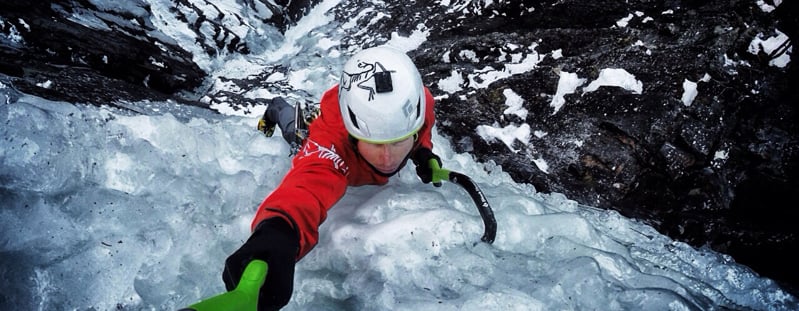
As hard as ice: Matthias Scherer's battle with a Norwegian winter
For ice-climber and Suunto ambassador, Matthias Scherer, winter is naturally a busy time. Recently, Matthias made a trip to Norway, where over the past few years, he’s gone in search of the ultimate ice lines. And this time, tucked away in the Fjords of the West Coast, he found just what he was looking for.
Approaching Fjåene Fossen © Matthias Scherer“Ice climbing, like alpinism is always a quest. A quest for the ultimate ice line,” says the German climber.It’s that quest which lead Matthias back to Norway – a place where he had tried twice in vain to scale the lines buried deep within in the Fjords near Bergen. He was forced to retreat on both occasions due to bad conditions.“This time we checked the temperatures via the internet and decided to give it a go during the beginning of February. We knew that we had to be prepared both mentally and physically to face this big adventure.”
A little clip of Matthias climbing in his home ground of Cogne, Italy in January.
Arriving in Norway, his ‘adventure’ started almost immediately when a snowstorm blocked all the roads on his way in. And when the expedition finally commenced, Matthias and his crew were faced with crossing a waist-deep river of freezing water before reaching their line.“The climb up ‘Fjåene Fossen’ proved to be, as expected, an epic battle: bad ice quality and lots of water and snow pouring down on us. After several hours we reached the top of the line in a raging storm,” he says. But for Matthias, achieving one objective only leads to the next, on the way down they discovered another awesome-looking line.“Two days later in an even heavier storm, we reached the top of that line. We named it 'Stormbringer'.”
On Pattinaggio © Matthias SchererYou’d think that after his Norwegian excursion, Matthias would kick back for a few days. Wrong. The climber has been busy climbing lines on his home turf of Cogne, Italy, as well as another trip back to Norway to climb in Rjukan. He's already looking forward to going back next year.
“And next winter, I’ll be back on Norwegian ice once again.”
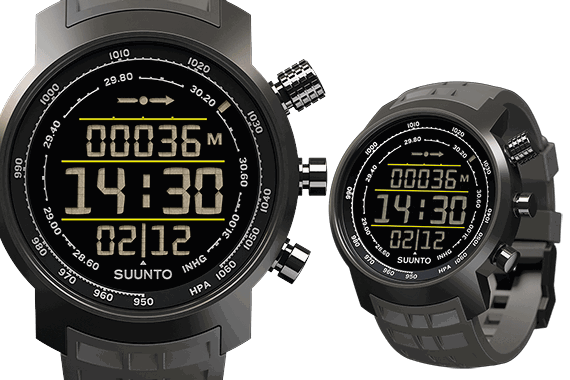
Suunto launches the Elementum Terra Stealth
The premium outdoor watch is now available in a subtle, more neutral color.
Suunto's latest launch can now be revealed – the Elementum Terra Stealth. The new color edition is a stylish solution for those who want to effortlessly blend in.
Inspired by the need for camouflage during special expeditions and quests, the Suunto Elementum Terra Stealth is characterized by neutral colors and offers a natural and discreet look.
It features anti-reflection surfaces and earth mineral inspired colors that ensure a harmonious integration with your environment. These are complemented by high-contrast lime-yellow detailing in the display.
The Suunto Elementum Terra is a superbly crafted timepiece and exclusively manufactured in Finland using the highest quality materials of stainless steel and sapphire crystal glass to withstand the elements. It features a 3D compass and also measures altitude and weather trends, ensuring it is robust and functional for adventure.
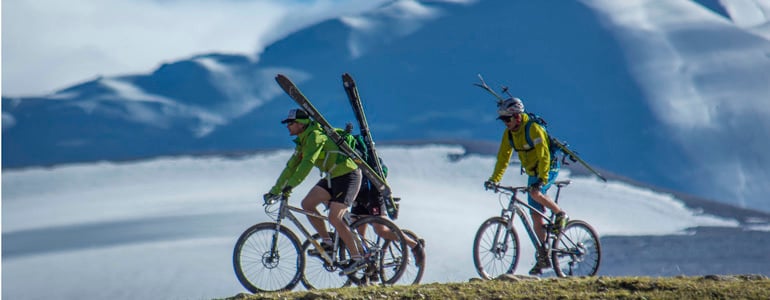
Mission to ski and ride the Himalayan greats
Three men, two 8,000ers, 7 days and 170km. Mode of transport? Bike and skis only. Welcome to the quest of ski mountaineers Benedikt Böhm, Sebastian Haag and Andrea Zambaldi. The German and Italian trio have just embarked on an epic mission to climb Shisha Pangma (8,013 m) then ride their bikes the 170 km to Cho Oyu (8,201 m) where they hope to make another speed ascent, all within a week.
They've spent the last week acclimatising up to 7,000 m and were all set to make their first summit attempt on Thursday September 18. However, bad weather and avalanche risk forced them to turn around. They're now back in base camp, preparing for a second summit bid.“Another attempt to climb Shisha Pangma is being planned and scheduled to happen within the next few days,” they blogged.
Big surprise of the trip so far? Bumping into Suunto ambassador Ueli Steck at base camp, no stranger to speed ascents himself.“Ueli gave many useful tips,” the guys said. Ueli climbed Shisha Pangma and Cho Oyu in 2011. The three ski mountaineers, who are supported by Suunto, can be followed online here.
All images © Elias Lefas
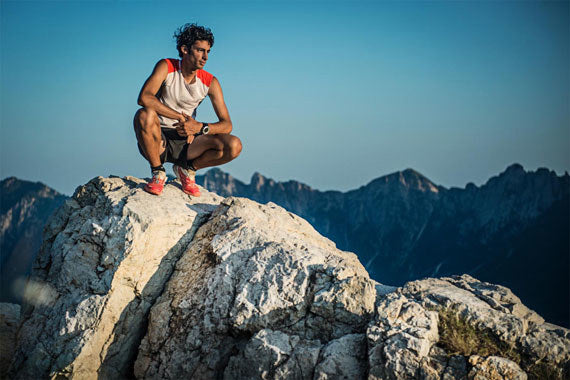
Kilian Jornet named Adventurer of the Year
He's blazed a trail across the mountains, set speed records on dusty trails to snowy peaks and above all, inspired a legion of fans to explore their own potential with his passion for the outdoors.
Kilian Jornet has now received some due recognition from those fans. The Suunto ambassador has been named National Geographic Adventurer of the Year.
Kilian was among several explorers, climbers and adventure athletes shortlisted by National Geographic magazine for the prestigious honor, which is decided by public vote.
They included long distance swimmer Diana Nyad, explorer Sarah Marquis, climber Adam Ondra and many other inspiring individuals with impressive achievements in exploration, adventure sports, conservation and humanitarianism.
A record number of 75,000 people voted in total. Kilian was recognised for his contribution to mountain sports, for his speed ascents of Mt Blanc and the Matterhorn and his humble mountain-loving philosophy.
“The most exciting thing is that this prize comes from the people,” Kilian says, “so I want to thank everyone who has voted for me and everyone who has supported me since I started on this. To feel that what I do can inspire someone, that it makes them go out in a quest for their dreams, that's what really matters.”
“It's a great honor,” he adds. “I don't run or make these records for the recognition, but it is nice to receive a prize where the people have voted for me.”
To find out more about Kilian's achievements and his Summits of My Life project, go to his website.
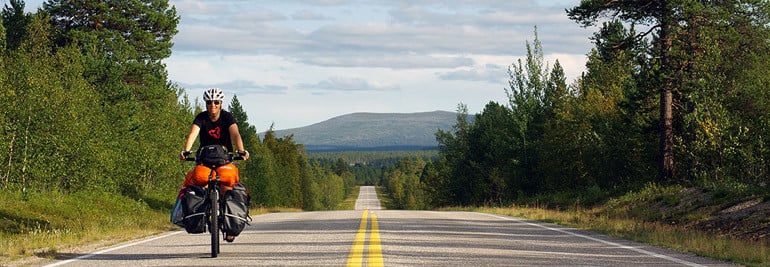
Couple depart on ultimate Nomad trip
Janick Lemieux and Pierre Bouchard are on the first leg of an epic cycle journey NOMADS² from northern Europe to the southern tip of South Africa in search of indigenous nomadic peoples. Janick Lemieux and Pierre Bouchard are no strangers to long cycle journeys. The Canadian couple previously spent six years on a 60,000 km 'cyclovolcanic' quest around the Pacific. For this trip, their plan is to cycle 35,000 km from Nordkapp Norway to Cape Agulhas, South Africa via 50 countries and dozens of nomadic groups. “We're embarking on an epic ride and a true voyage of exploration!”So far they've already cycled across Norway and encountered the Sami reindeer herders. “We snaked our way up north amidst its jaw-dropping fjords and celestial plateaus jutted with glaciated peaks and entered Sami (Lapland), traditional territory of the first nomads on our list, and were riding on the lookout for reindeer, their summer pastures and their herders,” the pair say in their latest dispatch.
Besides Norway, they've also cycled across Finland's wilderness. “It's a land of magnificent taiga forests speckled with a multitude of lakes, vital marshes, and vast expanses of tundra covering summits and upper reaches of tunturis or fells. Reaching some 800 m above sea level, the venerable bald ridges are the sole survivors of billion of years old lofty mountain ranges. With their abundant lichens and few mosquitoes, they provide ideal summer grounds for reindeer. It's been a real immersion in this amazing land,” they add. It's not just remote indigenous peoples whom the pair have met. They also managed time for an encounter with an equally engaging team of individuals – the workforce at Suunto's HQ in Vantaa, Finland. We wished them the best of luck in their onward journey.
Images: © Pierre Bouchard
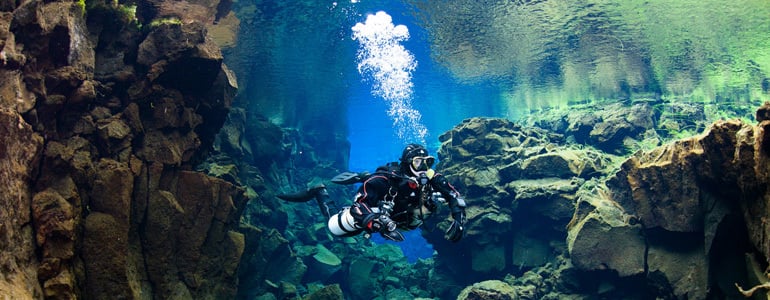
Diving the Shipwrecks of Bell Island
Suunto ambassador and underwater explorer Jill Heinerth dives the world's most incredible locations. Bell Island, Newfoundland is one such site. The video below shows why it's a diver's paradise.
Tell us about the Bell Island and its wrecks.
Bell Island is one of the few locations in North America that was under attack by German forces during the Second World War. In 1942, U-boats raided the island twice, sinking four iron ore carriers and destroying a loading wharf, killing more than 60 men. During the war, the mines on Bell Island, Newfoundland supplied iron ore that accounted for one-third of Canada's steel production. Germany knew that they could interrupt the flow of ore, even temporarily, and Canada's war output could be seriously affected.
Click here to find out more about Jill Heinerth
What drew you to dive there?
I was part of a team documenting the recovery of a sextant from the wreck of the Rose Castle. Rick Stanley, owner of Ocean Quest Adventure Resort, worked for over a year to secure the correct permits and line up provincial conservators to preserve the important artifact that will be eventually be displayed in an extensive museum on Bell Island.
Why is it such an amazing dive location?
Newfoundland is a great destination for the adventurous divers. Today, divers visiting Newfoundland’s rich waters, can dive these remarkable wrecks that have transformed into stunning and colorful reef structures.
Is there more to explore there?
In the summer, divers can also enjoy diving on icebergs and swimming with whales that gather in the area to feed on capelin. I’ve been recently working with other cave divers to document the submerged mines which cover over 100 square kms. This coming season, mine operators hope to open diving activities to qualified cave divers visiting the area. The mine is still filled with all the equipment and artifacts of operations there. Seeing the large equipment, miner’s graffiti and personal items is an interesting opportunity.
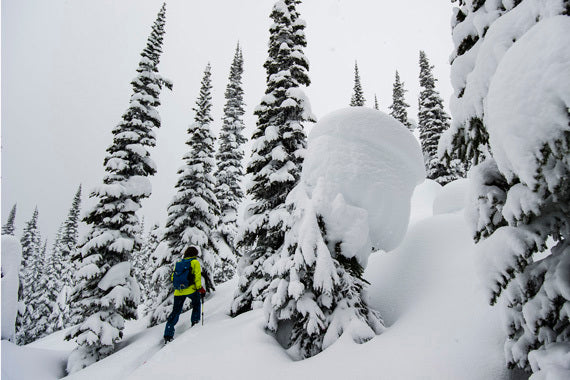
Greg Hill battles deep snow
Sooner or later every adventure hits its challenges — and that's proving the case for Greg Hill. The ski mountaineer is almost half way into a 31 day mission to ascend 100,000m and he's been averaging a vertical ascent of over 4,000m a day since the beginning of the month. While lots of snow is good news for those big smile-inducing descents, it's been making the ascents a lot less fun for Greg.
“Days five to seven were really bad and hard days,” he says. “The temperatures were a little warm and the snow very wet, the mountains were going through a state of change and avalanching regularly — some very large. I needed to play it very cautious and stay in the trees. The options were limited and some very uncomfortable days happened.”
One of the biggest problems, as Greg's recent Instagram post makes clear, is the build-up of snow under the skis.“It added massive weight and progress was hard. I was screaming really loud obscenities to make myself feel better!”
On Sunday Greg took a much-needed rest day to allow for the avalanche danger to subside. “When the dust cleared the skiing has been great. The last two days have been off the charts! Great powder skiing, glaciers, summits and loving the days.”
So far Greg is on track but uncertain weather next week is a cause for concern. The body is also holding up for now. “It's as hard as I imagined, requiring me to dig deep. For 10 hours a day I pretty much hike all day with small intervals of great skiing. The body is feeling the repetitive motions —I'm having to do lots of stretching and eating.”
One thing that will help Greg in his 'March Madness' quest to ski 100,000m is your support. Follow him via Instagram and Facebook. You can also find more adventure on our own Facebook page.
Top picture ©Bruno Long.
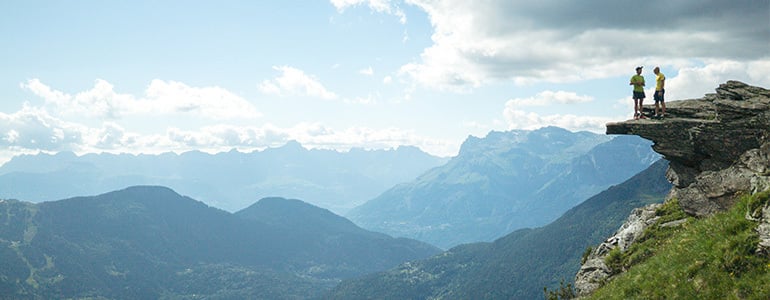
Karl meets Kilian
It’s not everyday that an athlete helps someone break his own records, but then Kilian Jornet is not your regular athlete. He belongs to the spirit of the mountains, where comradeship and camaraderie count more than rivalry and competition.
So when he was contacted by Karl Egloff, a runner who’s broken his speed ascent records on Aconcagua and Kilimanjaro and was looking to meet up, Kilian’s response was, ‘great idea’!
Hit play to see these two mountain athletes meet up for the first time.
© Montaz-Rosset Film “Nothing was set-up,” says the film maker Seb Montaz. “It was really the first time they met. They were both excited to meet and I hope people see them laughing together – there was no rivalry.”
The 34-year-old from Ecuador was in Chamonix with ambitions to break Kilian’s 4h 57m speed record on Mt Blanc. As it happened the attempt was called off as conditions were not ideal but it proved to be a good experience for Karl.
“It was amazing,” he says. “It was really nice to climb with him. We went for a training run and talked, comparing our different experiences. There was no rivalry. He’s so inspiring – just to meet him was an honour.”
Karl and Kilian discuss routes up Mont Blanc. © Sébastien Montaz-Rosset
In February Karl knocked almost an hour off Kilian’s 12h 49m record up and down Aconcagua which he set last December. It follows the record of 6h 42 he set on Kilimanjaro in 2014, beating Kilian’s 7h 14 record from 2010.
But in the unfamiliar ground of Mt Blanc, he says he was happy to learn from Kilian. “He showed me just how fast he is at lower altitudes! My strength is going steeply up to altitude which is why I can make a difference on Aconcagua and Kilimanjaro. Living at altitude helps a lot! But there are no glaciers to cross and Mt Blanc is a very technical mountain.”
“I’ve heard so many stories about Chamonix and it really is an amazing place to be,” he adds.
Karl is returning to Quito, Ecuador for now and has big dreams for 2016. He's hoping to continue with his 7 Summits quest with expeditions to Denali, Elbrus and Antarctica.
© Karl Egloff
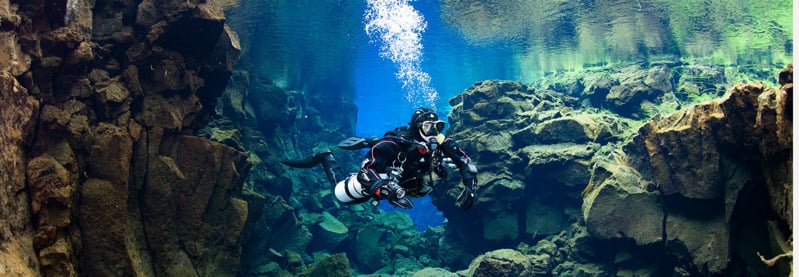
Heinerth publishes children's book
He's a manatee named Chester and he's not in great shape. Meet the star of Jill Heinerth's new children's book. Just published, Chester the Manatee and the Very, Very, Terribly Bad Itch is part of Jill's quest to educate children about the state of our water. Below she tells us about the new book, and why she feels manatees have much to teach us.
So what's the idea behind the book? Chester the Manatee and the Very, Very, Terribly Bad Itch is a book that follows the life of a gentle manatee facing struggles from a very annoying itch. He reaches out to a young girl who helps him discover the cause of his problem. The little girl helps Chester by teaching people about keeping water clean. Chester the Manatee supports children who feel different, embrace their special characteristics. The book celebrates unique kids as remarkable people who help teach others about important issues.
You're quite a fan of manatees right? The book is a part of my efforts to educate people about their water issues. Recently some misguided but well-meaning people started to lobby to end activities that allow people to swim with manatees. Anyone who has had the privilege to swim with manatees is transformed by the experience and there is no evidence to support that any of the wild manatees are harmed. They have special refuge areas to escape and yet they leave the refuges to interact with humanity. I truly believe the manatees are trying to teach us something. None have been harmed by human interaction in the water and yet many die of cold stress each year. Their habitat has been destroyed by our use of herbicides, pesticides and fertilizers on the golf course style lawns we keep in Florida. The bottom vegetation is now gone and replaced by filamentous algae that does not have the nutritional value they require. They have to leave the warmth of the springs to swim out to the Gulf of Mexico to feed. Some don’t make the return trip in time to beat cold weather and henceforth die of cold stress.
I realize that it is critical to help everyone understand that humans’ swimming with manatees are the best chance we have to protect the water they are swimming in. People have to learn from the operators in the area about how to change their behaviors to protect water resources. I hope this book will help.What’s the story about? Beyond the environmental message of protecting water, I want to empower kids. Sometimes we all feel like we are different or that nobody understands us. I am trying to encourage kids to be confident and understand that they can help change the world.What else are you up to right now? I have a busy summer ahead with work in Greece, the Azores, Newfoundland and England. I’ll be doing some filming of caves, wildlife, wrecks, icebergs and a newly opened flooded mine. I’m also looking forward to going back to Cuba soon. I am working with National Geographic on a project that involves an international team of scientists and explorers. We’re looking at early human remains and unique paleontology as well as getting a better understanding of global climate change.
You can order the book on iTunes here.
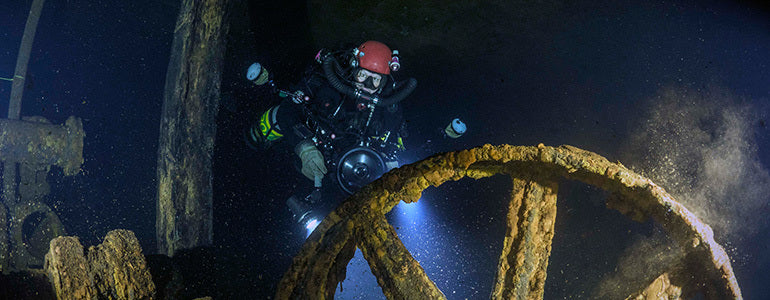
Diving in the abandoned Bell Island mine
It’s the Royal Canadian Geographical Society’s Expedition of the Year – the Bell Island Mine Dive. Suunto ambassador Jill Heinerth is part of the team exploring the vast and submerged mine system. Scroll down to learn more and to see images of this incredible dive site.
Canadian underwater explorer and technical diver Jill Heinerth is part of a team now exploring 100 km of long-abandoned mining passages beneath the seafloor of historic Bell Island, which lies off the coast of Newfoundland, Canada “The plan is to open this site for guided cave diving for experienced divers,” Jill says. “Ocean Quest Adventure Resort already boasts the ‘Truk of the North’ in terms of shipwrecks. Couple that with the mine, icebergs and humpback whales, and you have one of the finest diving destinations on the planet.”
“Shipwrecks, the mine, icebergs and humpback whales – one of the finest diving destinations on the planet.”
© Cas Dobbin 2016The plan for the expedition is to establish some primary guidelines for others to follow in the future and to get an idea of what was left in the mine when it was abandoned in 1966. So far, they have found everything from the remains of a miner’s lunch kit, an antique Pepsi Cola bottle, to large pumping equipment and pressure dampeners. “The walls of the mine also tell an important story; miners left behind basic graffiti on the walls such as columns of addition but also painted caricatures in lampblack and white crosses where their colleagues died. It all tells the anthropological story of mining.”
Click for more about Jill Heinerth
© Cas Dobbin 2016The expedition will also explore the island’s staunch local culture and WWII shipwrecks in its harbour. “The high-grade ore coming from the Bell Island mine was critical to shipbuilding during the war,” Jill says. “In 1942, a German U-Boat sunk four ore carriers and blew up the loading wharf on Bell Island. Seventy men died. The four shipwrecks are a part of this project and I will be back to document them in summer.” © Cas Dobbin 2016Engineers have helped the team assess and mitigate risks in the dry part of the mine. The hematite ore walls can collapse simply by leaning against them. Underwater, they have experienced whiteout conditions from inflowing meltwater. The remaining electrical supply line is an entanglement hazard. “We have to employ very prudent and conservative diving protocols to keep everyone safe and that means a big team topside to help in the logistics and safety.”
“It all tells the anthropological story of mining.”
The team includes some of the best technical divers in the world. Most are from Canada, and two others are from Britain and Germany. “The majority of the team is using rebreathers in order to lessen the impact of percolation from the ceiling and to increase warmth and comfort.”
Click for 7 off-season tips for divers
Fierce weather has created problems for the expedition. Blizzards, gales, floods and complete melts have each made things difficult. “The weather made travel across the Tickle to the island impossible on some days and on others we had a river of rushing meltwater flooding the infrastructure we had built for the project. It has not been easy, but we are learning about the forces of nature that will affect further exploration here.”
To follow news about the Bell Island Mine Dive expedition, click here.
Main image: © Cas Dobbin 2016
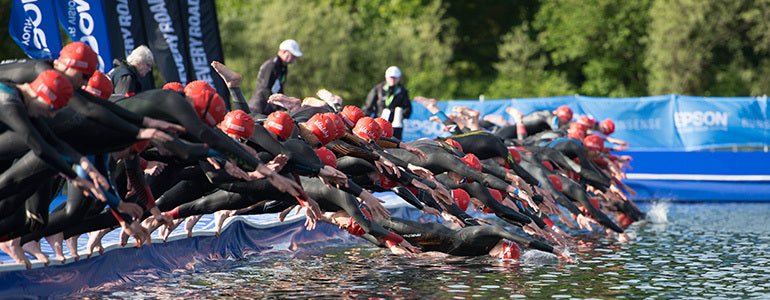
Only Human
Suunto UK has partnered up with the Columbia Threadneedle World Triathlon Leeds, England. We recently ran a contest to find a lucky competitor to share his training tips and the experience of taking part. The winner is Dan Blackburn and this is his second update about his preparation for the big day this June.
"The Easter eggs have been eaten and we’re half way through April. That means one thing – the one big push before WTS Leeds.
Now is the time for focus. For determination. For a bit of selfishness.
I’ve been flat out at work recently, and carrying a bit of an injury too (a sore calf after my last 10k). And that means I’ve been neglecting the training and nutrition a bit.
But having had a few days off over the recent bank holiday weekend to recharge the batteries (I knew I was tired but never expected to sleep for 12 hours straight on Good Friday) I’m feeling refocused and ready to redouble my efforts.
So for the next couple of months I’m going to be a bit more selfish. I’m going to take lunch hours. I’m going to leave on time(ish). I’m going to change things up a bit.
It’s the perennial quest for balance – work, family, training, nutrition, rest, sleep – something I fail to master most of the time.
It’s easy to get cross about it, and easy to make excuses, but as my coach always points out, you’ve just got to be objective about it – look at it dispassionately, in the cold light of day and it’s obvious what you need to do.
I work too much. That’s the long and short of it. So that’s where I’m going to make a few changes in the run up to the race. A few shorter days and lunch hours don’t have to make me any less effective at work.
Ultimately, it’s about admitting to myself what is blatantly obvious to everyone else – I’m only human.
So with my injury, I’ve been sensible. My natural inclination is to push on through. But instead I listened to my coach and triathlon buddies and pulled out of my first race of the season - I just couldn't risk doing 15k at race pace in the Clumber Park Duathlon.
And I’ve started stretching and foam rolling properly. I know this should have been an integral part of my daily routine, but if I'm honest it's the first thing to fall by the wayside when I'm busy. So let this be a warning - do as I say, not as I do! Get stretching, get rolling, get yourself a massage.
The second realisation is more obvious, but no less frustrating. Even with a proper training regime laid out and even after quitting drinking, I am a thirty something office monkey, not a pro triathlete. Unlike the Brownlee brothers I have a job that eats up 50 or 60 hours a week, plus a wife and two young kids who need my time and attention.
Maybe it’s the break from work but I feel a bit more zen-like than I have for a while. I have a plan, I know what I need to do, but I’m not going to beat myself up for failing to hit Brownlee-esque heights.
And with those parameters in mind, I’m going to give it my very best shot.
So armed with a new sense of perspective, I did a quick recce of the WTS Leeds bike course this weekend just to see what lies in wait for me. It’s a proper bike course for proper bike riders - with loads of undulation and very few moments when you can relax. It’s hilly, it’s technical, it’s going to be tough. So make sure you’re putting some tough bike sessions in!"
Read more
Meet the everyman who’s taking on the World Triathlon, Leeds
10 Ambit3 hacks for triathletes
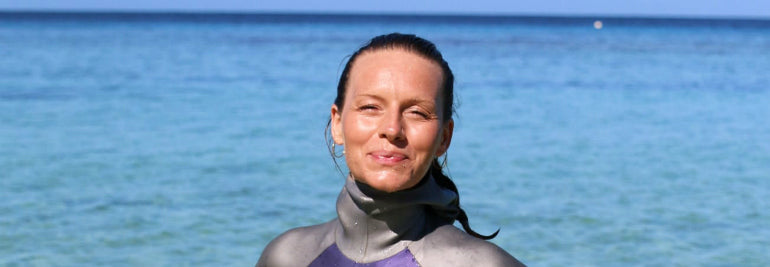
World Champion, World Record Holding, World Renowned Freediver Alenka Artnik Joins Team Suunto
In 2020 Alenka Artnik dived to 114m, deep beneath the surface of the Red Sea on a single breath, her mind and body working seamlessly together. Arriving on the surface fully aware and in control, Alenka claimed the title as the deepest female in freediving discipline CWT, Constant Weight, diving with a monofin.
Discovering the sport at a time in life when she needed inspiration and was ready for a change, Alenka was 30 and living in Slovenia when she hit the water running! Following a freediving session with friends, she quickly blew the other divers out of the water with her unearthly natural talent for apnea.
Alenka’s potential was identified early on by both her fellow divers and later her first instructor. Seizing the day, she packed her fins and moved to the vibrant diving hub of Dahab. Immersing herself in its freediving community, she found the bottom of the Blue Hole at about 100m on a breath-hold in her first season of training!
The new Suunto ambassador and freediving world champion Alenka Artnik summed up her passion for the sport with these words:
“We come from the sea and so it feels natural... It isn't just physical, it is mental, spiritual, and mind-blowing. I use the tool of freediving to explore my spirituality and carry it through into each part of my life.”
Eat, sleep, break dive record, repeat!
In 2016 Alenka celebrated her first World Record at the CMAS World Championships diving to 92m CWT wearing bi fins. The following year the record-breaking freediver won gold again at the same championships and graduated to the 100m club (CWT) at the Caribbean Cup, making her only the fourth female freediver to be crowned in the club.
Alenka, like so many other freedivers, has always dived with Suunto. Her Suunto D4i Novo was her first freediving computer, and now she dives with a Suunto D6i Novo, but soon she will be going deep with the D5. It is fair to say Suunto dive computers have always been at the centre of Alenka's training.
World Champion Alenka explained that she currently uses multiple Suunto devices when diving, "At the moment I'm using my two Suunto D6i Novo devices. One is for notifications of my depth that I wear on my neck weight close to my ear and the other I wear on my wrist so I can check my dives during training." She went on to say that analysing her dives afterwards is a key part of her dynamic training schedule and Suunto’s high performance in this area is one of the many reasons she chooses Suunto every dive, “I record all my dives in my training logbook with the help of the MEM Logbook function. I always rely on the logbook function of my Suunto dive computers to study my dives.”
Finding her flow
In recent years Alenk has continued to win competitions and break records but her focus has shifted from “winning” to a quest to optimize her performance, she summed it by saying “getting better motivates me.” The gains from this new approach are evident in her calm and collected surface protocols, something she attributes to entering the flow state, the world champion describes what she means by this:
“In the end, I think that it is all about the flow state. You put yourself in a mental state of flow. It is the peak performance, the maximum performance- but effortlessly.” summarises Alenka "For me, it is about how to do the best performance with the least effort possible. More with the mind and less with the physical effort. Good awareness, being super present the whole dive and less with the physical effort.”
100% commitment
Ten years on since Alenka discovered freediving, as she approaches 40 and with future hopes of freediving being billed at the Olympics, she is continuing with her hard push to dominate the depths with ease. Alenka is also part of a growing number of athletes in this discipline that are trying to demystify the sport, increase its popularity and ultimately help save our oceans.
“Freediving promotes a healthy lifestyle, but best of all more freedivers promotes more Ocean Ambassadors to protect our water planet.” Alenka Artnik
All images from Alenka Artnik ©
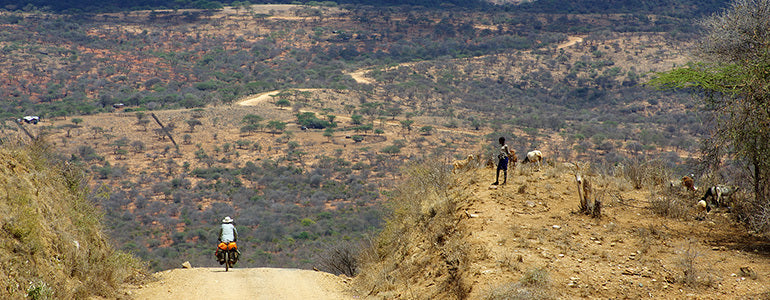
Meet the nomad who has cycled around the globe four times
Pierre Bouchard began cycle touring in 1990 and has since travelled all over the world, covering the distance of four loops of the planet. In this first of three instalments* about the “Nomads” we asked him what he’s learned.
© nomadesxnomades.com
Pierre Bouchard’s life on the road began with sage advice from a philosophy professor; “the ideal would be to travel the world and account for it,” the professor suggested during a lecture. Then a philosophy student, Pierre says as soon as he heard this his “mind flew right out the window”.
Shortly after, he dropped out of university and set out to study what René Descartes called “the great book of the world”. He pedalled more than 71,000 km through 18 countries in the following seven years. His partner Janick Lemieux joined him on the road in 1997 and together they’ve cycled through more than 60 countries in the Americas, Europe, Asia and Oceania – and currently Africa.
Their expeditions are about far more than seeing sites and sampling foreign food, however. The couple approach their journeys as acts to build understanding and solidarity between distant cultures. They are particularly interested in remote and nomadic cultures and have given hundreds of lectures about their findings and experiences.
© nomadesxnomades.com
“By sharing what we learn, and by informing our hosts on the road about our own culture, we contribute to a sense of humanhood which is the basis for genuine solidarity!” Pierre says. “We‘ve learned that we all have the same needs and are all subjected to the same existential conditions, so why not help one another?”
“People are very curious and somehow don’t feel threatened by strangers on loaded bikes. They come close, greet us and inquire about the obvious journey we’re on which often triggers a reflex of human solidarity where invitations for a drink, meal, shower and shelter fuse.”
© nomadesxnomades.com
Through 1999 to 2009, the couple circumnavigated the Pacific Rim, riding along its tectonic faults and ridges, pedalling from one active volcano to the next. Travelling clockwise from Vancouver, they cycled about 60,000 km in six years, using 300 volcanoes to create their itinerary and hiking to, around or to the summit of around 60.
“One of the advantages of having a theme to explore is that they take you to places you would never imagine – you don't usually think of Vanuatu or the Solomon Islands as your typical bike touring destinations, but they rock,” Pierre says. “The Ring of Fire quest took us to some of our planet's wildest spots and warmest people.”
© nomadesxnomades.com
Pierre and Janick are currently cycling through Tanzania, having made it more than half way through their 35,000 km NOMADS² cycle tour. The three-year expedition is focused on deepening their understanding of the nomadic way of life. Starting in Norway, they cycled north to Lapland, and then south down through Eastern Europe, the Middle-East and the east of Africa. Along the way they have contacted various nomadic peoples, such as the Sami in Scandinavia, the Roma in Europe, and other tribes, seasonal herders and hunter-gatherers. After cycling 21,000 km in 21 months, they’re pausing their journey shortly in Tanzania, and will return after a 15 month break to complete the journey north up the west of Africa to Morocco.
© nomadesxnomades.com
“We have learned that being a nomad is becoming more and more difficult because, due to the population explosion, the world is getting crowded,” Pierre says. “The race to exploit natural resources by the more powerful often pushes nomads out of their natural territories to which they often have no legal deeds. There is also development playing a role, with new school-going nomad generations often not willing to continue to live simply like their parents and ancestors. For now, nomadism is fast disappearing.”
“Nomads are in symbiosis with nature and for this reason, it would be good for the planet if more of us were to adopt the way of the nomads. They definitely inspire us to have a lower and sustainable impact on the environment and its resources!”
*Stay tuned for our second and third stories about the Nomads, and find out which countries in the world are the most cycle-friendly!
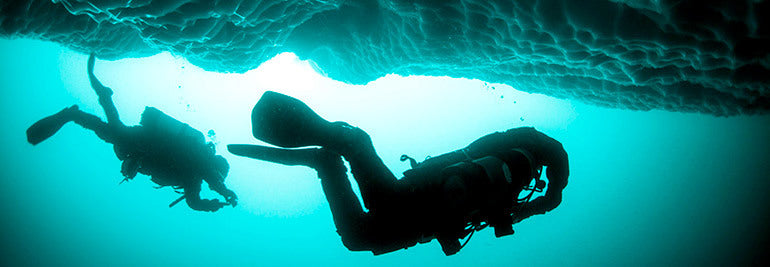
Explore a frozen world with Jill Heinerth
If you dream of diving unique and undiscovered places – let’s say, under Arctic icebergs – there are very few people in the world who can tell you what it’s like. One of them is Jill Heinerth, one of the first people in the world to dive underneath an iceberg back in 2002. Here’s a few bits of wisdom about the world’s coldest, loneliest places passed on from one of the sport’s most knowledgeable individuals.
It’s one of most unique experiences you can have
Diving inside an iceberg in Antarctica was one of the most remarkable things I have ever seen underwater. There were no guidebooks to prepare me for those experiences. Nobody had done it before.
It’s nothing like cave diving
Iceberg diving is actually very different from cave diving. There are odd vertical currents and surging swells created by mixing waters and bouncing masses of ice heaved up and down on waves. Most iceberg diving is done along a face or wall of ice rather then inside a cave-like area. There are significant risks from going inside a crack or crevasse. Icebergs, especially in the north, are dived at the end of their lifespan. They are fragile. They roll, crack and move in a way than crush a diver in an instant.
Wanna dive an iceberg? Head to Iceberg Alley
The best place to dive icebergs would be to head to Iceberg Alley in Newfoundland, Canada and dive with operator Ocean Quest Adventures in the early summer months of June and July. They have experience guiding groups to safely dive the icebergs and when you get your fill, you can swim with whales, dive WWII shipwrecks and even dive in a flooded mine.
This isn’t for dive rookies
You’ll need to have proper exposure protection for the cold water and advanced diver training that includes excellent mastery of buoyancy control, comfort with shooting a DSMB, using a compass and drifting for a safety stop in open ocean. You also need to descend quickly without a reference line since the most dangerous place to be is near a face of ice on the surface of the water.
And you’re going to need a helmet
In case a loose piece of ice strikes your head. I have been swept through an iceberg on a rocketing current, been inside a cave when the doorway disappeared, was pinned to the sea floor by a raging flow of water and watched an entire iceberg explode into a sea of slush.
Speaking of risk, it’s cold – really cold
Cold water increases the risk for any dive profile. How long you can tolerate the chilling temperature? Cold water can affect your mobility and comfort if you are not well dressed. You also need to consider drysuit flooding and managing thermal profiles to avoid decompression stress and gear-related risks such as regulator free-flow. You also need to get back quick – a long float on the surface while you await a pickup isn’t an option.
We’ve all made plenty of mistakes in diving. If you haven’t made mistakes, you likely aren’t diving. I’m not embarrassed to report that I have made my share. The important thing is that you plan conservatively enough to absorb the issues and come home safely.
Icebergs scare me. Always. But my careful forays into the deep chill have been incredible experiences.
You’ll literally be swimming through history
There is no doubt that icebergs are stunning visual environments. You might be shoulder to shoulder with an ice wall formed by 10,000 years of compacted snowfall or be witnessing the fizz of earth’s atmosphere erupting from some ancient timeframe. Scientists certainly have a lot to learn about sea ice and declining ice shelves around the world and in my lifetime, it is predicted that we may have an ice-free Arctic. Is it worth the risk? I’ll leave that to adventurers and scientists to consider on their own.
You can come dive icebergs with me
I will be making The Journey of the Iceberg next fall. On Sept. 23, 2017 I will be departing on Adventure Canada’s boat to make a trip from Greenland, across the Davis Strait and down the Labrador Coast to Newfoundland. We have space for ten divers to come along on this amazing opportunity to dive in places never visited with SCUBA! Icebergs calve from the coast of Greenland and make this circular journey across the strait. We’ll follow their course and have incredible diving and exploration opportunities along the way.
READ MORE
SIGNAL SEEKER – A SHORT STORY ABOUT BO LENANDER'S LIFELONG JOURNEY
EXPLORING THE LITJÅGA CAVE
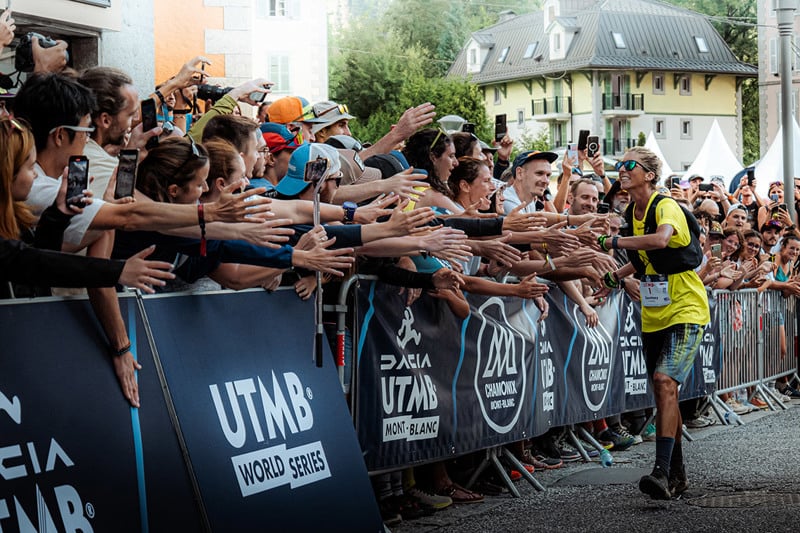
Suunto partners with the UTMB World Series
Sharing the same passion for sports and the outdoors, UTMB® World Series and Suunto, known for their world-renowned GPS multisport watches and training tools, have announced a global partnership, that will see the two companies work together to contribute to the positive development of trail running and help individual runners reach their goals.
Suunto have supported adventurers since 1936 and have been involved in trail running since its inception. Their legacy in the sport is enriched by a strong team of elite runners, including UTMB Mont Blanc winners Courtney Dauwalter, Francois D’Haene and Pau Capell. Suunto watches feature award-winning design, industry-leading battery life, reliability, and purpose-built features for training and racing.
As Official GPS Watch and Technical Partner of the UTMB World Series, Suunto will support runners in navigating the trails and achieving their dreams across the 41 UTMB World Series Events, by bringing its heritage and experience with GPS sports watches. Athletes with a Suunto Vertical or Suunto Race watch can download intuitive GPS maps in three different map styles with important landmarks, contour lines, water, paths and different sorts of terrain highlighted. Maps are available for each UTMB World Series Event, whether you are running the 100K CCC® (Courmayeur-Champex-Chamonix) in the European Alps, the 50K Kodiak Ultra Marathons by UTMB in California, the 100M Black River Peak race in the sugarcane fields for Mauritius by UTMB... or any other race of the circuit.
Frédéric Lénart, UTMB Group CEO, said:
“We are delighted to join forces with Suunto who has over 80 years’ experience in creating products that runners can rely on in the most extreme conditions. With Suunto becoming Technical Partner of the UTMB World Series, we will enable runners to live adventure that stays with them forever, helping them to take the first step and keep on moving.”
Hannu Korpivaara, Suunto Brand and Marketing Director, said:
“We firmly believe that collaboration empowers companies, communities, and individuals to evolve. It fosters relationship-building, innovation, and effective problem-solving. We are honored to partner with the UTMB World Series and to connect with all the runners out there. Together, we aim to contribute to the positive development of trail running and help individual runners reach their goals.”
The 2024 UTMB World Series kicks off this month with the Tarawera Ultra-Trail New Zealand by UTMB from the 17-18 February. This inaugural event of the year welcomes trail runners of all abilities and promises unforgettable moments in the most stunning scenery of Rotorua.
About UTMB® World Series
UTMB® World Series is the world’s ultimate trail-running circuit that unites the sport’s biggest stars and passionate runners through the best, leading international events in the most stunning locations. Built on a passion for the mountains with sustainability at its heart, UTMB® World Series gives all trail runners the chance to experience the UTMB® adventure across the world, with events taking place across Asia, Oceania, Europe, Africa, and the Americas. It is the only place where runners can begin their quest to Dacia UTMB® Mont-Blanc, France, where the prestigious UTMB® World Series Finals will be held. Launched in May 2021 through the collaboration between the UTMB Group and The IRONMAN Group, the UTMB World Series circuit brings together many of the best international trail-running events on the planet.
For more information, visit https://utmb.world/.
About UTMB Group
Since the creation of Dacia UTMB® Mont-Blanc in 2003 by a group of passionate friends, UTMB Group has been the driving force behind the development of trail running. The Dacia UTMB® Mont-Blanc is the sports pinnacle event, and every year, 10,000 runners earn their place on the start line. UTMB Group also pioneered the LiveTrail® technology, an innovative digital service that supports the management of endurance races. Revered by hundreds of thousands of athletes, UTMB® has become a global, premium, and leading brand. In May 2021, UTMB Group partnered with The IRONMAN Group to launch the UTMB® World Series, now in its second year, which brings together many of the best international events on the planet to provide exclusive access to the sport’s pinnacle event, Dacia UTMB® Mont-Blanc. The UTMB® World Series is built on the founding principles of Dacia UTMB® Mont-Blanc: surpassing oneself; fair-play; respect for people and the environment; and solidarity.
Find out more at https://utmb.world/.
About Suunto
We stand for adventure. Pioneering has been in our DNA since 1936, when Finnish orienteer Tuomas Vohlonen invented a more accurate and reliable compass. Today, Suunto is at the forefront of design and innovation for sports watches, dive computers, compasses and digital services used by adventurers and athletes around the world.
Since 2022 we have conducted cradle to grave Life Cycle Assessments (LCA) for our new watch models to understand their environmental impact and to help us improve our ways of working. The remaining emissions we offset with Verified Carbon Units.
We pride ourselves on the fact that Suunto products are not only robust, but also have an everyday aesthetic that reflects our Nordic identity. Suunto's headquarters and own factory are located in Vantaa, Finland.
Find out more at apac.suunto.com
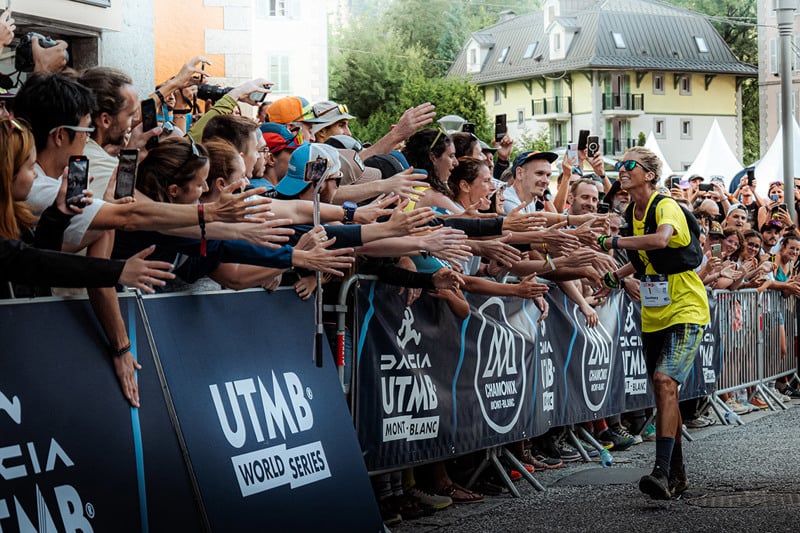
Suunto partners with the UTMB World Series
Sharing the same passion for sports and the outdoors, UTMB® World Series and Suunto, known for their world-renowned GPS multisport watches and training tools, have announced a global partnership, that will see the two companies work together to contribute to the positive development of trail running and help individual runners reach their goals.
Suunto have supported adventurers since 1936 and have been involved in trail running since its inception. Their legacy in the sport is enriched by a strong team of elite runners, including UTMB Mont Blanc winners Courtney Dauwalter, Francois D’Haene and Pau Capell. Suunto watches feature award-winning design, industry-leading battery life, reliability, and purpose-built features for training and racing.
As Official GPS Watch and Technical Partner of the UTMB World Series, Suunto will support runners in navigating the trails and achieving their dreams across the 41 UTMB World Series Events, by bringing its heritage and experience with GPS sports watches. Athletes with a Suunto Vertical or Suunto Race watch can download intuitive GPS maps in three different map styles with important landmarks, contour lines, water, paths and different sorts of terrain highlighted. Maps are available for each UTMB World Series Event, whether you are running the 100K CCC® (Courmayeur-Champex-Chamonix) in the European Alps, the 50K Kodiak Ultra Marathons by UTMB in California, the 100M Black River Peak race in the sugarcane fields for Mauritius by UTMB... or any other race of the circuit.
Frédéric Lénart, UTMB Group CEO, said:
“We are delighted to join forces with Suunto who has over 80 years’ experience in creating products that runners can rely on in the most extreme conditions. With Suunto becoming Technical Partner of the UTMB World Series, we will enable runners to live adventure that stays with them forever, helping them to take the first step and keep on moving.”
Hannu Korpivaara, Suunto Brand and Marketing Director, said:
“We firmly believe that collaboration empowers companies, communities, and individuals to evolve. It fosters relationship-building, innovation, and effective problem-solving. We are honored to partner with the UTMB World Series and to connect with all the runners out there. Together, we aim to contribute to the positive development of trail running and help individual runners reach their goals.”
The 2024 UTMB World Series kicks off this month with the Tarawera Ultra-Trail New Zealand by UTMB from the 17-18 February. This inaugural event of the year welcomes trail runners of all abilities and promises unforgettable moments in the most stunning scenery of Rotorua.
About UTMB® World Series
UTMB® World Series is the world’s ultimate trail-running circuit that unites the sport’s biggest stars and passionate runners through the best, leading international events in the most stunning locations. Built on a passion for the mountains with sustainability at its heart, UTMB® World Series gives all trail runners the chance to experience the UTMB® adventure across the world, with events taking place across Asia, Oceania, Europe, Africa, and the Americas. It is the only place where runners can begin their quest to Dacia UTMB® Mont-Blanc, France, where the prestigious UTMB® World Series Finals will be held. Launched in May 2021 through the collaboration between the UTMB Group and The IRONMAN Group, the UTMB World Series circuit brings together many of the best international trail-running events on the planet.
For more information, visit https://utmb.world/.
About UTMB Group
Since the creation of Dacia UTMB® Mont-Blanc in 2003 by a group of passionate friends, UTMB Group has been the driving force behind the development of trail running. The Dacia UTMB® Mont-Blanc is the sports pinnacle event, and every year, 10,000 runners earn their place on the start line. UTMB Group also pioneered the LiveTrail® technology, an innovative digital service that supports the management of endurance races. Revered by hundreds of thousands of athletes, UTMB® has become a global, premium, and leading brand. In May 2021, UTMB Group partnered with The IRONMAN Group to launch the UTMB® World Series, now in its second year, which brings together many of the best international events on the planet to provide exclusive access to the sport’s pinnacle event, Dacia UTMB® Mont-Blanc. The UTMB® World Series is built on the founding principles of Dacia UTMB® Mont-Blanc: surpassing oneself; fair-play; respect for people and the environment; and solidarity.
Find out more at https://utmb.world/.
About Suunto
We stand for adventure. Pioneering has been in our DNA since 1936, when Finnish orienteer Tuomas Vohlonen invented a more accurate and reliable compass. Today, Suunto is at the forefront of design and innovation for sports watches, dive computers, compasses and digital services used by adventurers and athletes around the world.
Since 2022 we have conducted cradle to grave Life Cycle Assessments (LCA) for our new watch models to understand their environmental impact and to help us improve our ways of working. The remaining emissions we offset with Verified Carbon Units.
We pride ourselves on the fact that Suunto products are not only robust, but also have an everyday aesthetic that reflects our Nordic identity. Suunto's headquarters and own factory are located in Vantaa, Finland.
Find out more at apac.suunto.com
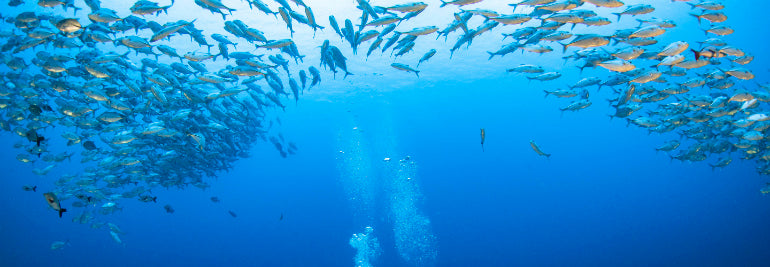
Changing the World from Behind the Camera
Steve Woods has amassed stacks of content illustrating his experiences underwater including thousands of photos that represent the true devastation of the human impact on our natural world. Through his photographic artistry he has successfully utilized his talent to tell the world this sad story that everything is not OK and we need to initiate change.
The Driving Force
Steve’s dedicated parents drove for hours across the UK so that they would be able to make their son’s dreams come true, they would take him to any shark exhibition they could locate until one day, there was to be a real shark on display. He was on the edge of his seat, apprehensive, and excited about what he was going to see. On arrival Steve rushed to find the shark only to be confronted with a papier maché model instead.
Unperturbed by the severe disappointment, the young wildlife enthusiast did not give up his quest to see a real shark.
© Steve Woods Photography
Steve began diving at nine years old and with his family and qualified alongside his parents and two sisters in Turkey when he was twelve.
“When I was a kid I used to watch old VHS documentaries, I had three or four of them that I collected over the years, relics from birthday and Christmas celebrations gone by I would view them over and over until they tapes wore too thin to play. At any chance I could I would beg my parents to take me down the local garden centre that had an aquarium inside to see the ragged tooth and the grey nurse sharks. I would sit there for hours just watching it slowly doing laps around and around the tank,” reminisces Steve.
Fifteen years later he saw the shark he had been dreaming of.
The Journey
Steve spent his early career working in journalism in the UK driven by a deep seated desire to change the world and make it a better place. Steve grasps the importance of illustrating the issues we face as a community and wants to reach people who perhaps have a lesser understanding of the impact of their everyday actions. During his journalist years he committed a lot of time uncovering the detrimental aspects of fish farming and fisheries and spent time underwater to see how the problems could be managed and minimised.
The 2008 shark experience Steve had in Indonesia stayed with him and he soon found himself burning his savings on new camera equipment, securing a one way ticket to Indonesia and leaving the world of British journalism far behind for a life of adventure and to use his photography skills to help protect the oceans.
Once he arrived in Lombok he took up work with local dive centres and photographed guests on their diving adventures so they could take home cool memories from their dive trips. The experience was valuable as it gave him a deeper understanding of how to capture light in water and the technicalities of shooting stills under the sea in order to capture the powerful and clear images he does today.
Soon he found himself involved in setting up a shark conservation foundation alongside a team of local groups and conservation projects called the Gili Shark Foundation.
© Steve Woods Photography
Gili Shark Foundation
“We began photographing sharks, we thought they were all the same as did the community. When we started identifying them we noticed there were many more than we initially thought there were. Gili Shark Foundation was a great way to get the whole island working together. Everyone was involved in shark counts, events and data collecting.” Steve had achieved what he set out to do by using his passion to highlight nature and the human impact.
After a successful time in the Gili islands he moved to Raja Ampat to continue working in conservation. Plastic is prevalent in remote areas, as well as most other environments and Raja is experiencing the same issues. Steve worked with the local communities to show them how to start and maintain effective conservation efforts in areas that have potential. The key to successful conservation projects is longevity with a clear plan for the future.
“The only way to change the human habits it by educating an involving the local communities. If you go in and rule over a population then it is an imperialistic act. When we came to Raja, the locals were well aware the plastic waste was increasing and that fish stocks were decreasing. We worked together to come up with a plan that would enhance their lives and make them more money.” Steve says.
Looking back on his career so far, he talks of many memorable moments working underwater including humpback whale, shark, manta encounters but he considers the smaller experiences that really stick with you as a photographer and as a human.
“Originally when we set up the shark foundation we were rescuing sharks from fisherman in Bali and then we got permission from the government to release them into a fishing projected area in Lombok. First time I had ever done anything like this. We completed research, spoke to people and made plans. Collected the animals and sent them off on a fast boat to be released into water. Who knows if they were going to survive, but we had given them a chance.” Steve says.
Three months later they identified that same shark by the dot pattern in the skin. Steve acknowledges this is a small achievement while 200-400 million sharks slaughtered every year, but this moment struck a chord and the feeling has stayed with him.
More and more he uses his photography working alongside marine conservationists to support their work and he hopes to grow this reach and increase the impact.
© Steve Woods Photography
The Future
“Visual language is so important nowadays, if people know they can change their minds.” Ask Steve how he will change the world in the future, he will tell you “one step at a time”.
© Steve Woods Photography
Suunto took five lucky competition winners of the trip to Raja Ampat on the Suunto D5 photo shoot, they were dive instructor Rosie Sheb'a from Australia, student Niko Lekhraj from Singapore, outdoor guide Anders Vestergård from Denmark, designer Xiaomo "Momo" Wang from China and nature activist Lilian Ellevog from Norway. See them diving in Suunto D5 images and videos.

The sheer audacity of Red Bull X-Alps
Race organizer Ulrich Grill explains the 2019 route at a press conference. © zooom.at / Red Bull Content Pool
When the race organizers of Red Bull X-Alps announced the 1138 km route for the ninth edition of the race, many athletes felt it is the most challenging yet. Race veteran Paul Guschlbauer, for example, said crossing the Alps from Germany to Italy, while facing strong winds, will demand every bit of his skill and strength.
“We still have so much snow in the Alps and there’s only four weeks to go,” Paul says. “It was snowing down in the city a couple of days ago, and we have to go up to 2500 m, crossing it by foot if we can’t fly. When there is so much snow in the high mountains the thermal uplifts we need to fly don’t develop. It could be tricky up there!”
Click here to read about Paul and his quest to catch the Eagle!
There are only 1138 Suunto 9 Baro Red Bull X-Alps Limited Edition pieces. One for every kilometer of the race!
The Red Bull X-Alps is an adventure race unlike any other. In the 2019 edition of the race, starting June 16, 32 athletes from 20 nations around the world will attempt to hike and fly across the length and breadth of the Alps, checking in at 13 turnpoints along the way. If the weather doesn’t play ball, they must hike insane daily distances with massive vertical gain.
With nearly double the number of turnpoints than in previous editions, and five zigzag crossings of the Alps, the athletes are going to be pushed to their ultimate potential. And fans are in for a treat.
For adventure sports fans, this race is almost addictive to follow. The live tracking system allows fans to follow their favourite athletes in real time. The race crosses through five alpine nations – Austria, Germany, Italy, Switzerland and France – and whole villages come out and cheer the athletes as soon as they see via live tracking they are passing through.
To give you a sense of the sheer audacity and scale of this race, here’s a preview of the route!
Salzburg to Gaisberg
Distance covered: 5 km
It’s race tradition to start in Mozartplatz in Salzburg, Austria, surrounded by the classical and natural beauty of this historic alpine city. The first turnpoint is only five kilometers away, but don’t let that fool you. Athletes must race up Gaisberg (1288 m) carrying their paragliding packs. It’s important athletes pace themselves well here, and catch a good thermal to carry them onwards. Every race, fans assemble at the top of Gaisberg and wait for the athletes to cheer them on.
Gaisberg to Wagrain-Kleinarl
Distance covered: 59 km
It might not seem like a long way, but remember the numbers alone don’t show the skill and precision this race demands. In this section, the athletes must navigate through a small flight path across a mountain range, while avoiding the Salzburg airport restricted airzone. At most turnpoints, athletes must sign their names on a signboard. The second turnpoint signboard is located right in town.
Wagrain-Kleinarl to Aschau
Distance covered: 148 km
One a clear day some of the best competitors might reach this third turnpoint in Aschau (615 m), Germany on the first day. Most will reach it on the second, after crossing the Hochkonig mountain group. Consider this leg the quiet before the storm; next they must make their first crossing of the Alps, from Germany south to Italy.
Aschau to Kronplatz
Distance covered: 268 km
Snow covered peaks, glaciers, the Italian Dolomites, fierce winds all put the pressure on in this leg. The fourth turnpoint is located at the top of Kronplatz, a 2275 m mountain, making careful flying incredibly important. Misjudge, and the athletes might land in a valley, and have to slog up to the top.
Land in the wrong place, and athletes have to hike to a launch spot. © Felix Woelk / Red Bull Content Pool
Kronplatz to Lermoos-Tiroler Zugspitz Arena
Distance covered: 381 km
After one epic crossing of the Alps, athletes must turn back, and cross north again. Strong northern winds are common, making for challenging flying. Adding to the challenge is the restricted airspace zone around Innsbruck, Austria, requiring a diversion north into Germany. The fifth turnpoint is reachable only after circumnavigating Zugspitze (2962 m), Germany’s highest peak!
Lermoos-Tiroler Zugspitz Arena to Davos
Distance covered: 483 km
The meeting place of the world’s tremendously wealthy, Davos, Switzerland, gets tremendously exciting as the athletes fly through, landing by the lake to sign the sixth turnpoint signboard. From this point on, the weather begins to play an even bigger role.
Red Bull X-Alps demands precision piloting. © Felix Woelk / Red Bull Content Pool
Davos to Titlis
Distance covered: 592 km
Bad weather is every athlete’s worst nightmare in this leg. Unflyable, and they have to hike to the top of Titlis mountain (3238 km) to sign the board at the seventh turnpoint. Restrictions put in place by the race organizers make accessing the top even more challenging. There is only one village that athletes are permitted to climb to the summit by foot from. And that village is way off course from the most efficient flight path.
Titlis to Eiger
Distance covered: 630 km
Famous for its intimidating north faces, Eiger (3970 m) is an icon of European alpinism. The good news for the athletes is there is no turnpoint to sign in at on the summit! Instead, they must prove they passed within a 1500 m radius of the virtual cylinder.
Eiger to Mont Blanc
Distance covered: 751 km
In this leg, athletes must travel north from Switzerland into France, past Europe’s highest peak, Mont Blanc (4810 m). Like the previous leg, there is no signboard at the summit. Instead, they must traverse the northern side, keeping the mountain at their left.
Mont Blanc to St. Hilaire
Distance covered: 847 km
One of the paragliding meccas of Europe, St. Hilaire in France offers easy take off conditions. The athletes can sail in quickly and sign the board at turnpoint 10, before launching again and setting off to cross the Alps again!
Paul Guschlbauer power hikes to his next take off spot during Red Bull X-Alps 2017. © Sebastian Marko / Red Bull Content Pool
St. Hilaire to Monte Viso
Distance covered: 965 km
Crossing from the north to the south-east, athletes head to Italy’s Monte Viso (3841 m), where they must again prove by GPS tracking that they passed through a 2250 m virtual cylinder. While not as famous as previous peaks, race organizers say turnpoint 11 might be the toughest because of the mountains and valleys athletes must navigate through to get there.
Monte Viso to Cheval Blanc
Distance covered: 1045 km
This is a new, unexplored area to Red Bull X-Alps. By this point, the remaining athletes that haven’t dropped out will be exhausted. Cheval Blanc, a 2323 m peak in the French Alps, will be one of their last obstacles to navigate past. This time, they are required to pass on the west, either by foot or wing.
Cheval Blanc to Peille
Distance covered: 1136 km
Here, at last, the clock stops. The ceremonial end is 2 km below on a float on the shore of Monaco. The Peille turnpoint (13) is located at a mere 709 m, a pimp squeak compared to the massive peaks the athletes have already endured. However, it’s small size is deceiving; because of the many hills preceding it, it’s all too easy to pick a bad thermal and wind up landing, and being forced to continue on by foot, losing precious time.
Peille to Monaco
Distance covered: 1138 km
The landing float in the glistening Mediterranean Sea will be sight for the tired eyes of the courageous athletes that made it through the gauntlet. It’s time to pop the champagne!
Red Bull X-Alps 2019 begins on June 16. Stay tuned for more of the action!
Lead image: © Felix Woelk / Red Bull Content Pool
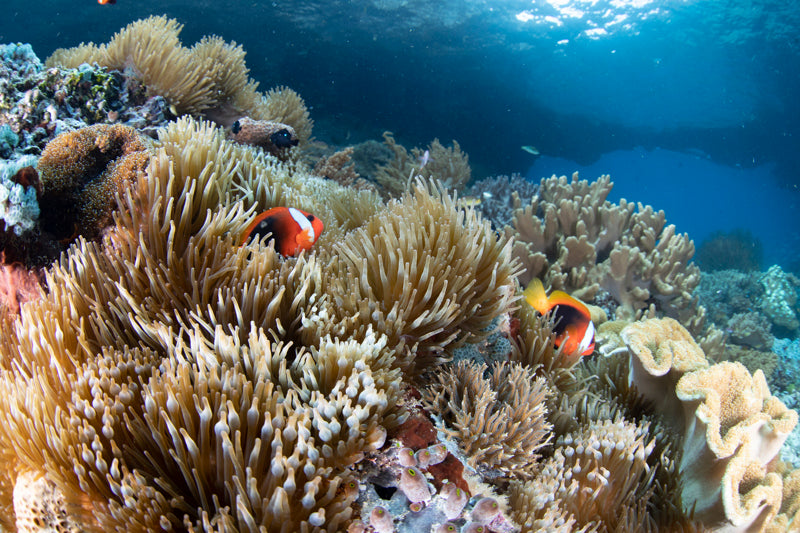
Max Ammer, Raja Ampat and the richest reefs in the world
Janne Kasperi Suhonen ©
Last year Suunto took a group of competition winners out to Indonesia for the Suunto D5 photo shoot to produce inspirational content. We had never explored these waters before and we soon saw the fruits of hard work. It was to say, nothing less than inspiring and the story behind this special location is just as wonderful.
Steve Woods Photography ©
The Best Diving in the World?
A young fisherman stood at the edge of the water on West Papua next to his canoe. Inside the canoe there were two turtles that he had caught on his morning excursion. Max Ammer walked past the fisherman by the canoe and immediately his interests were sparked. After a brief chat and small negotiation, the pair agreed a fair price for the sale of the turtles.
Once the money was exchanged, Max sprang into action and suddenly flipped the first turtle over the side of the canoe to which the fisherman promptly jumped in the shallow water after it. In the splash and confusion Max then took his chance flipped the other turtle off the other side of the canoe back into the ocean and watched it happily swim away. With the fisherman staring in awe at what was in his understanding a ludicrous occurrence, Max simply told the fisherman, “I like turtles”.
That same fisherman was soon to become the first dive guide at the five-star eco resort run by Max Ammer on Kri Island in a unique location where in an extraordinary case, the reefs are getting richer.
Steve Woods Photography ©
The Concept
Max Ammer went to Papua after a long life of nature filled early years, growing up in Nigeria on an animal refugee camp run by his parents. They nursed birds, crocodiles, chimpanzees to name but a few species back to health and released them into the wild if they could. These formative years have certainly affected Max and led him on his quest for protecting nature.
Max learnt to dive while in the special forces in 1982 but it was not an enjoyable experience for him.
“I learnt not how to quit but how not to quit.” Max talks of the key message he took home from his diving course.
Thirty years later and Max arrived in the pristine island paradise on Raja Ampat Islands, off West Papua in 1989 in search of wrecks and little else. He had a tip off whilst living in the Netherlands that led him to pack his bags and head off around the world in search of sunken treasures. The tip was from Max’s landlord who had been based in the Pacific at the end of the war and according to the story, he witnessed the Allied forces bulldozing aircrafts and Jeeps into the water.
At that time his job was building and restoring Harley Davidsons and classic bikes from the war so he was certainly interested. On arrival at the remote island he found the jeeps with ease and began removing the data plates to sell to members of the Keep Them Rolling group of classic car collectors for approximately 250$ a piece.
“I found them. I still have a glove compartment form a WW2 jeep over there now.” Max muses as he sits by the ocean beach front of the Eco resort in Papua.
He found the aircraft wrecks were slightly harder to find. After an initial investigation of the area he thought it best to return with a zodiac, a Bauer compressor and some equipment to dive in and find them. Morotai Island was the location of the Allied forces strategic base where 50,000 soldiers served under Supreme Commander for the West Pacific, General Douglas Macarthur. There were about 500 aircraft take offs every day from the base as he island was a major base with it being just a short step over to the Philippines and Borneo.
In his search for the wrecks around Morotai Island Max formed friendships with the locals. He opened up honest communications and he fell in love with their warmth. He describes their nature as friendly and at some point, he thought he wanted to work with them, he wanted to build something great and he wanted to see change in the future.
Steve Woods Photography ©
The Dive Show
The idea of the eco resort idea came to light as it was the perfect balance of working with the locals and working with people while protecting nature. Max took their ideas to a dive show with intention. He designed an iconic stand never seen at a dive show before and filled it with plants and local artefacts to entice people to the yet unbuilt resort. He decided that if he landed three sets of guests they would go ahead with the project plan; he sold two years’ worth of guests.
“I rushed back to the island and told the guys we have to build this thing the guests are coming!
Sometime later, lost in time, it was ready. I was actually walking out the back door with the build team as the guests walked in the front!” Max remembers fondly.
The locals lived a remote life and a lot of his team previously worked as loggers, fisherman, shark fin fisherman and poachers having had little or no access to education.
Now part of the crew, they have all ceased what they were doing and are serious about protecting the reef. They earn more money, have security for their families and access to education while working on this unique reef system that is getting richer in fish species and corals.
Since the beginning Max and the team have put the protection of the burgeoning ecosystem at the forefront of their priorities. This has proven to be a wise move as the fruits of the work can be seen in the thriving fish counts.
Steve Woods Photography ©
Conservation on Raja Ampat
A group of scientists from Conservation International visited the eco resorts on Raja and conducted studies and counts documenting the numbers of fish and coral species along the house reefs. They counted the largest amount of fish species in the world which led to National Geographic reporting on the resort which of course was fantastic exposure.
Twelve years later, scientist Gerry Allan returned to do another count and found that there had been an increase of 91 species in the same area totalling 374 species of fish on one dive, making it the richest area in the world.
Max puts this down to beginning the protection before the reef had been destroyed unlike many other marine protected zones. They are not wasting energy trying to revive an ecosystem that has already been destroyed, they are building on a top of a flourishing base and these hardy coral polyps seem able endure a larger fluctuation of sea temperatures than other species so are being transported around the word to be implanted and successfully grown in other systems.
“Scientists are looking to see if it will be possible to transplant our corals from our home to other areas where they are not surviving. We are not sure but people are researching this possibility. Perhaps our corals are more evolved, stronger, but I can’t really answer that yet.” Says Max.
The diverse variety of natural schemes in Raja around the two resorts include bay areas and swamps amongst the lush swarms of vegetation. The water is warm and the equatorial location has constant access to nutrient rich waters bringing in a healthy supply of food to support the great wealth of nature that relies on this orchestra of occurrence.
There are of course stresses on the environment, including those caused by running two resorts on the wild and remote island but Max sees it is all about balance in this situation.
“There are always stress on environment. What we tried to do at the resort is plan how we can help educate people for the future.
We also work with the government, but they do not do enough, they should be more involved in our opinion, and we try to work with them and educate them, then hopefully there can be encouraged to be more proactive and initiate change.”
As it stands Raja is able to handle more tourism but the expansion must be on the right terms and make the least footprint.
Regimented planning and organisation will be the key to successful growth including processes such as strict waste management schemes, green energy generation and protection of nature in the area will have a positive influence. Educating guests on their own environmental impacts as visitors is an important part of the eco experience. Beginning with using eco-friendly sunscreen that will encourage better behaviours that they can take home with them and spread the word amongst peers. The resorts are aided in their plight of protection by a constant stream of researchers including overseas students that come and study the area and collaborate with the ground team.
Environmental dangers are changing across Papua, including increased plastic pollution being a serious risk to the natural environment. The ground team are more than aware that they should be considerate and careful and encourage guests and visitors to adopt the same attitudes while sharing knowledge and ideas and working together so they can grow and concentrate on creating a wonderful future for the local area, its inhabitants and beyond.
“We hope in September to welcome five students to conduct their own research and look at different aspects of the issues we are facing here to help towards making things better and better for the future.” Max continues with an excited tone, “we love working with Conservation International and we are blessed to have this opportunity to work alongside them.”
Steve Woods Photography ©
Flying High for the Future
There is one surprising element of this conservation project that is somewhat unexpected, their collection of Bell 47 helicopters hidden inside a huge hanger just behind the beach that houses enough spare parts to build a further three helicopters. Max built the machines himself and the advantage is they are easy to maintain. They are the best auto rotator helicopters that keeps the weight in the tips of the blades allowing them to land and take off if they unfortunately fail. Max Ammer is interested in aviation and they serve as a useful tool in protecting the local area. Illegal loggers, fishermen and general rogue behaviours are easily spotted from above.
The passengers and captain can even see the dive sites from the air, flying over the water they can view corals, the aggregation of fish and whereabout they gather on the dive site. Best of all, they can see the large animals. Max talks of his record sightings, 132 manta rays on one flight and 33 dugongs on another.
“You owe it to yourself to be positive. Negativity is no good, be positive and look at all the things many things you can do at least you did the right thing. If you going to be negative it’s not going to do you any good.” Max Ammer, Raja Ampat Eco Resort and Papua Diving.
Videographer: Janne Kasperi Suhonen www.jannesuhonen.net/
Photographer: Steve Woods stevewoodsphotography.com
The lucky winners of the trip to Raja Ampat were dive instructor Rosie Sheb'a from Australia, student Niko Lekhraj from Singapore, outdoor guide Anders Vestergård from Denmark, designer Xiaomo "Momo" Wang from China and nature activist Lilian Ellevog from Norway.You can see them diving in our D5 images and videos and will also hear some of their comments from the trip during the next few weeks so stay tuned.
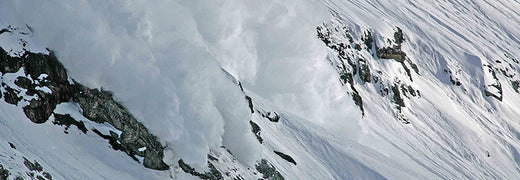
What rules does Greg Hill live by? Watch and see
Watch Greg’s video below to learn the rules and find out why they are important for you too – then scroll down to our interview with Greg to learn more about the life experiences that shaped them.
Greg, let’s start with the obvious: tell use about that avalanche!
May 15th 2014. Deep in the heart of Pakistan, at 5500m, as far from rescue as possible. I only broke my leg, but was very lucky to have lived at all. It was only 30cm high, but it was a few hundred meters across, but the entire feature that I was skiing slid for about 700m vertically.
What did you do wrong?
There was simply nowhere to go – and that was my technical mistake. What I did wrong was skiing a feature with no escape routes or safe spots. I skied like I was able to outrun an avalanche. A small ski cut would have triggered the thing and I would have been on top. But the bigger rule I broke was rule number one – not being afraid enough. I also broke rule number two – the partners I had there weren’t my normal partners. My normal partners would have questioned me more. They didn’t question me enough. Did they learn something from this? I bet they did.
Why did you need to be in that avalanche?
The funny thing is, I had lasted so many years without any issues – I needed that slide to keep my ego in check. There weren’t red flags popping up. We had waited a bunch of days for the snow to settle. The mountains were dormant. But I still broke the rules.
What’s your biggest tip to help you follow the rules?
Keep asking yourself questions. As you’re hiking up. Am i being afraid? Am I well-trained? Do I have the knowledge to back my decisions? Are my partners adding more? Always remember – you don’t know you're making poor decisions, until you experience a consequence.
What can we learn from you next?
This is a lead-in to my terrain tricks video – we’ll discuss concrete, tangible terrain decisions that will help you find ways to wander around the mountains and stay safe.
Stay tuned for more mountain advice from Greg Hill in December!
READ MORE
PREPARE FOR SNOW
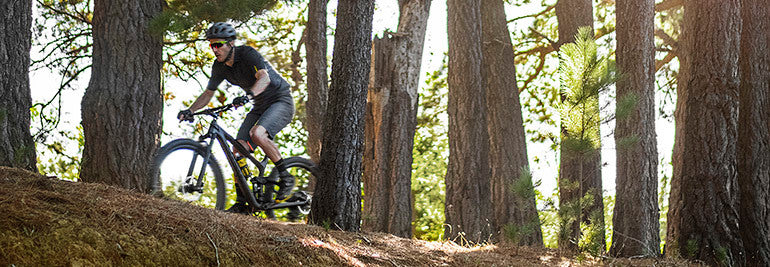
6 ways to find new MTB trails (that don’t involve Google)
Reaching for the Google is an instinctive impulse to answer almost every question that pops into our heads. With countless important questions, such as, “what is the world’s ugliest dog?”, or, “what to do if a ginger kid bites me?”, the internet has an answer for everything.
Yes, it’s also a valuable place to search for new MTB trails. But sometimes what is mirrored back is impersonal, superficial and without context. It lacks the richness that comes from hearing from a real person. Ask any investigative journalist, and they will tell you, you can only get so far with Googling; finding people to talk to is where the real story is.
To help you get the scoop on the most awesome local trails, we’ve put together a list of sources to consult.
Talk to your local bike shops
Bike mechanics and retailers talk to local trail aficionados everyday on the job. Chances are they are one themselves. Take your bike in for a tune up, and strike up a conversation about the local trails. Make your question personal, rather than general: where are your favorite places to ride around here? Many shops organize group rides for their customers.
Visit your local MTB club
This will be a goldmine of intel. Most larger cities have MTB clubs or meetups, which usually have club outings and meetings. Get in touch, go along on a ride. Usually every club has a few people who all the other members revere as gurus of sweet trail. Volunteer for trail maintenance work that trail advocacy groups and clubs do. When you give, you are also more likely to receive!
Stop and say hello
If you’re out on a trail and cross paths with another MTBer, greet them and strike up a conversation. He or she might have some trail secrets to share that could open your horizon of biking possibilities.
Check out our heatmaps
The Suunto app’s Heatmaps feature allows users to select different activities – mountain biking, hiking, running and so on – to find places and trails popular with other users. Zoom in and look more closely at the paths, switch to satellite or terrain maps, to see whether the paths are forest roads or single trails and to better gauge popularity. And look at where people aren’t riding; maybe there’s something worth exploring there? Another trick is to switch to the trail running heatmap because trail runners usually prefer single trail – this might help you hone in on the best rides.
Follow other riders in Suunto app
In addition to using heat maps to find places to ride on Suunto app, get social: start following other Suunto app users, engage with them and see where they ride. You can create routes based on your friends’ activities and sync those to your Suunto for navigation.
Import routes from Strava
You can find awesome rides by following people on Strava. You can then save their routes and use them in your Suunto for navigation. You can also find and create routes and sync them to your Suunto with other external route tools or services, such as Komoot, Outdoor Active and Wikiloc.
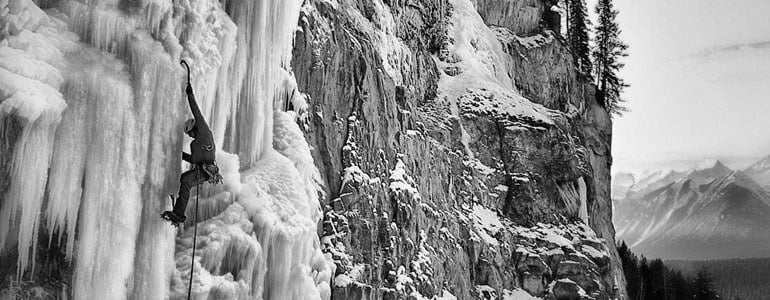
Early season ice score in Canada
Scoring early season ice: it's always a challenge and a gamble – but one that paid off for Tanja Schmitt and Matthias Scherer, who ventured to Canada in search of cold November climbs. In their own words, they tell the story of their adventure below and scroll down to see the video: Reborn.
The search for early season ice is always a voyage into the unknown. It causes many questions: has the ice already build up, how are temperatures going to develop, how many snow has fallen and is it going to be already a threat regarding avalanche risks?
Whilst the winter in the Alps often doesn't come before December, it can often be found full-on in November in the canadian Rockies. And so both climbers heeded towards the Rockies in hope for early season ice. But this year the Rockies were also still dripping with water instead of solid ice.Matthias on Whiteman Falls ©Tanja Schmitt
And so Matthias and Tanja found themselves Drytooling under a warm clear sky instead of ice climbing in cold winter light. The positive fact about that resulted in an enhanced training, and by the end of their Drytool-cycle both climbed 10 times M9+ in an hour: a fact which gave them confidence for what laid ahead.
In the second week of November the cold finally arrived with icy temperatures around minus 25°C. The ice formed. On November 12th Matthias and Tanja could start their ice season together with Steve Swenson with the classic ‘Murchison’ on Icefields parkway.
The climbs were freshly formed, kind of ‘shock-frozen’ and still thin. No traces indicated a previous climb, arising the common questions: is it already possible to climb? Might it not be a better idea to still wait? Is protection generally possible? Is the climb worth the risk? It is these questions early season ice climbing is all about.
Pointing the way to the Sorcerer
In the course of the second November week temperatures dropped even deeper: On november 29th the team climbed ‘Whiteman Falls’ with temperatures around minus 27°C, making the climb very interesting. Next day they went together with Canadian ice climbing legend Raffael Slawinski to Field for a longer gully climb.
With temperatures around minus 30°C degrees thin icicles and pillars were no option and steady movement a clever choice. So they soloed the easier parts just to keep moving and not to wait too long. It is when ice screws start to stick on your mouth whilst cleaning and your complete movements start to get slower that a cold day indicates itself...a very cold day. The ice becomes difficult to climb. The air crystal cold. Days unforgettable!
But no Canadian trip is complete without the ghost valley. And so at the end of their trip Matthias and Tanja once again teamed up with Steve Swenson for an adventurous trip. Next to hours long bush-walks and river crossings, ice climbing in the Ghost valley is all about getting in there first place with your car: snow packed roads, slippery river crossings and route finding in general are the challenges of the car 'pilot'. And so the four pitches of awesome ice were well earned: the ‘Sorcerer’ is by many means a great climb on an outstanding place and gave our trip an unforgettable ending!
Main image: ©Tanja Schmitt




























































